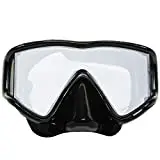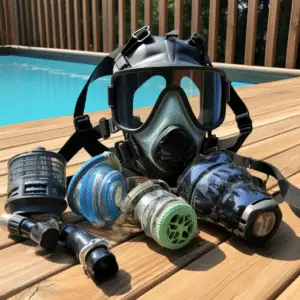Diving mask with Purge Valve are the quintessential piece of equipment that is used in multiple underwater activities and water sports. They come in different styles and models, but a recent trend in scuba diving masks includes a purge valve. They are heavily debated among the diving community, with strong opinions on both sides of the debate. Purge valves are found in snorkeling masks and occasionally in scuba masks – so are they worth getting? Or are they just a gimmick?
| Diving Mask with Purge Valve | BRAND | EXPERT RATING | PRICE |
|---|---|---|---|
 | TUSA Sport Store |  | |
 | EVO Store |  |
How Does A Purge Valve Work?

Before we begin to understand how to use a purge valve, it’s helpful to illustrate its mechanism. It is a one-way valve, usually located in the nose pocket of a diving mask. It is designed to “purge” or empty the mask of any water that might have collected inside the mask. As you can imagine, if too much water collects inside a scuba mask and the diver is already too deep, there is a potential risk of drowning or pulmonary aspiration (inhaling foreign objects or water through into the lungs, a serious and potentially fatal condition).
Modern purge valves are basically a silicon flap that is designed to stay closed unless forceful exhalation through the nose opens it up. The valve only allows water to flow in one direction, from inside the mask to out. It does not allow water to enter into the mask (which is, by definition, the purpose of any valve).
Purge valves found in scuba masks and snorkeling masks are designed in much the same way, as masks are often interchangeable. Purging a mask is a necessary process for any underwater activity, and there are other ways around it without the need for a purge valve.
Are Purge Valves A New Invention?
Diving mask with Purge Valve, Most scuba masks these days do not have purge valves, and many scuba divers have never even learned how to use them. This may give you the idea that they are a recent invention that hasn’t gained widespread attention yet. However, purge valves are actually part of the design for the first scuba masks!
When scuba diving was still relatively new and equipment was still in its experimental stage, the masks used were very large and heavy. They were made of some type of metal, shaped like a fishbowl, and with a visor (or three) to help the diver see in the water. They were a massive, heavy part of the diving suit. Due to their size, they have a high internal volume which meant purging the mask was a necessary feature.
Purge valves like the ones we see today have been around since the 1920s, but different designs were available even before. They went out of fashion when it became easier to empty the mask of collected water with other methods. Their recent rise in popularity is probably due to changes in design and the materials used to make the watertight seal and/or the purge valve itself.
What Are The Benefits Of Having A Purge Valve?
Diving mask with Purge Valve, Whether or not you have a purge valve in your mask, you will inevitably need to find some way to purge a flooded mask. Scuba masks are designed to have a tight fit, but there are several ways that water can find its way into the visor. These are only some of the many reasons for mask flooding:
- Facial hair is notorious for breaking the seal created by the rubber around a scuba mask. Stray hairs also have the same effect.
- Moving your face underwater (such as when you smile) may move the mask and break the seal slightly.
- Strong currents can move the mask and flood a mask easily.
- Masks with sub-par seals or defective silicone seals can let in water.
As we’ve previously mentioned, there is a technique that scuba divers use to clear a flooded mask without the need for a purge valve. It is much more difficult to master this technique than to learn how to use a purge valve. Also, an added advantage of purge valves is that there is no need to use your hands when purging.
Divers can carry equipment or cameras when underwater and purge their masks as needed without the need to stop and put down any equipment. So, scuba masks with purge valves are suitable for divers who may not have free hands during a dive (such as photographers and others who carry equipment). In other words, it comes down to convenience, which may differ from diver to diver.
Finally, if you are using a high-volume mask, a purge valve is required because it may be harder to build up enough pressure to purge a high-volume mask.
Are There Any Disadvantages To Using Scuba Masks With A Purge Valve?
Diving mask with Purge Valve, Many scuba divers prefer not to use a mask with a purge valve, and they aren’t wrong either. It is simply a matter of preference. There are two main disadvantages to having a purge valve. Firstly, the valve may fail to work, thus rendering it useless and equivalent to a valve-less mask.
These days, purge valve failures are rare, as innovative manufacturing technology allows companies to engineer the mask to specific measurements and have an accurate valve. Of course, a defective or damaged valve could potentially fail to work. It can also get clogged underwater and may be difficult to clean in that situation – cleaning the valve thoroughly after a dive is important to avoid clogging.
The other major disadvantage is that having a purge valve makes it more difficult to perform a nose pinch technique to equalize the pressure on the ears, risking barotrauma of the ears (burst ears). Because divers need to withstand higher water pressure, the pressure difference needs to be equalized in the ears and masks.
Because a purge valve takes up some space in the mask (around the nose), pinching the nose is harder to do. For many divers, this is the main reason not to get a scuba mask with a purge valve. In any case, it comes down to personal preferences because it is not inherently a risky feature to have in your mask.
A Review Of The Most Popular Masks (with purge valve)

Diving mask with Purge Valve, Although ultimately it is your decision whether to use this type of scuba mask, we decided to give you reviews of popular masks that come with a purge valve. Regardless of the type of mask you are using, the most crucial factor for it to function properly is that it should fit you well. Modern masks usually have two seals, and both of them should be in contact with the skin to keep leakage to a minimum.
The best way to put on a mask is to fix it in place without tightening the strap first. After making sure that the seals are touching your face, tighten the strap (but don’t go too tight). A deep breath through your nose should be enough to create a pressure difference and fix the mask in place.
1. TUSA Sport Imprex 3D Purge Mask
Diving mask with Purge Valve,We expected much more out of this model, but it wasn’t designed as well as we thought. The three-window visor provided enough peripheral vision, but as the lens was not treated with an anti-fog coating, we resorted to using the tried and true toothpaste trick to keep using the mask. The hyper dry snorkel was as advertised, with both valves functioning very well; we didn’t mind the mouthfeel of the snorkel either.
What we really didn’t like was the fit. There is a very fine line between a perfect seal and painful pressure points with this mask. While the pure silicon skirt didn’t let any water in, it was very painful to wear no matter how loose we buckled the strap. We think the design may be more suitable for teens or people with smaller facial structures. The mask digs into the nose (from above the lip) and the cheeks. The purge valve worked well, but it was hard to use the mask for longer than 20 minutes due to the pain caused by its awkward design. Although this model is very popular, we can only recommend its use for snorkeling as it would be too uncomfortable at increased water pressure when scuba diving.
2. EVO Tiburon 3-Lens Panoramic Dive Mask
Diving mask with Purge Valve, A very durable and strong contender for the best scuba mask we have ever tried. The visor is wide enough to give a full view of your surroundings, so wide that you could forget that you’re wearing it. The hypoallergenic silicone does a very good job at keeping the mask in place, and we found very minimal leakage. We tried the purge valve, and all it took was a short exhale to clear out any water in the mask quickly and efficiently. It was comfortable to wear, even as we dived deeper into the ocean. It’s surprising because the glass looks to be heavy-duty and scratch-resistant.
EVO doesn’t claim to have an anti-fog coating, but the mask performed well with very minimal fogging (if any at all.) It was easy to give it a quick freshwater rinse because there aren’t many nooks and crannies, so we don’t expect there to be much salt buildup. It has two straps to keep the mask in place, both adjustable with buttons to achieve the perfect fit. Our entire testing team absolutely loved this mask, and we understand the hype there is around it. If you want to use it for snorkeling, you won’t find a separate snorkel difficult to use because it won’t get in your way. It comes in five colors that are great but not as important when considering high-quality materials and superior design. This is a diving mask we can definitely recommend with no regrets.
Summary
A purge valve is part of a scuba mask used to empty any waters collected in the mask during a dive. It may be found in all types of diving masks, but opinions on its usefulness differ in the diving community. We hope we have provided ample information for you to make the right choice of mask for yourself and that our recommendations are useful somehow. If you are unsure about using a purge valve, you can always opt for trying one out (borrow or rent), which can help you make up your mind once and for all. There is no right answer because both types of masks are useful, whether they have a purge valve or not.
